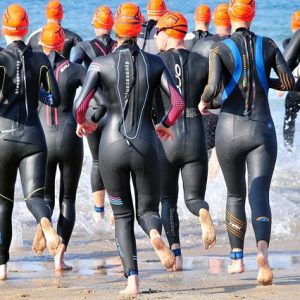Breathing is one of the aspects that must be controlled the most when doing any type of sport; and it becomes even more important in the case of swimming, where we must adapt to the aquatic environment. If you want to know how to learn to breathe when swimming, we will tell you what you should know.

However, before giving you the guidelines to achieve it, you should know that, as a general rule, what you should do is take in the air when you are with your head out of the water, and then expel it when you submerge again. However, the theory may not be as easy as the practice, so if you have trouble breathing in the water, in addition to following our recommendations you will have to practice.
Swimming benefits
Before explaining how to learn to breathe while swimming, we are going to review some of the numerous benefits of swimming, among which are the following:
- Low impact on bones and joints. By immersing the body in water to enjoy this sport, we make the body weigh less. In this way it does not receive the impact of the asphalt or hard surfaces as it happens in other sports; and this means that the joints and bones wear less and are better preserved.
- Greater flexibility and elasticity. Swimming uses the vast majority of muscle groups in both the upper and lower body, in addition to the head and trunk. This makes the joints more flexible, with toned and strengthened muscles.
- Burn fat. Depending on the intensity and in optimal conditions, swimming can burn 500-6,000 calories per hour. For this reason, it acts as a powerful fat burner that you can use if you are interested in losing weight.
- Improves the respiratory system and increases lung capacity. Learning to breathe is a key step to be able to enjoy a swim that, with each stroke and breath, improves the respiratory system, while helping to increase lung capacity.
To all these benefits we must add its advantages at the cardiorespiratory, neuronal, cognitive or psychological level, among others.
Instructions for learning to breathe while swimming
When it comes to knowing how to learn to breathe when swimming, you have to take into account a series of steps to follow, which are simple and will not make you very complex. What you should do is the following:
- When swimming front crawl you will have to turn your head to the side in order to get your nose and mouth out of the water, to catch your breath. Although a priori it may seem a bit complicated, once you do it little by little you will see how it comes out automatically.
- What you must do for this is to turn your head to the opposite side of the stroke. In this way, if you are moving forward on the water propelled by the left arm, you will have to turn your head to the right to inhale, and vice versa. This way you can inhale the air you need to continue swimming.
- Once you withdraw your left arm and start to move forward with your right (or vice versa), you will have to turn your head towards the center. In this way, what you will do is that both the nose and the mouth remain under the water, a moment in which you will have to release all the air that you have collected.
- Then you will have to turn your head to the right when you push yourself with your left arm (or vice versa) and you will take a breath again, at the moment that both your mouth and nose are out of the water.
- In butterfly style, what you should do is breathe in when your body is out of the water, and release it strongly while you are submerged. If you swim on your back you will not need any type of special breathing technique, since in the latter case both the nose and the mouth will be out of the water all the time.
Tips for learning to breathe while swimming
To practice swimming you can do some breathing exercises, such as the following:
- Blow into the water through the mouth. To do this you will have to take air through your mouth when you are out of the water. You will then blow slowly as you go down into the water and come back out of the water without stopping your blowing.
- Blow into the water through the nose. As in the previous case, with this exercise you will have to take a breath through your mouth and blow slowly through your nose as you dive.
In either case, these exercises should be performed calmly. It is not necessary to try to last a long time underwater, but gradually evolve until you get a longer time.
You should also keep in mind that when learning to breathe while swimming you may be able to swallow some water. If this happens to you, you should remain calm and simply swallow it as you would a glass of water.





